This position has been computer-generated.
One can note the spiritual variation 1 Ra3 Nb5!
3 - homework n°2: white to play and draw
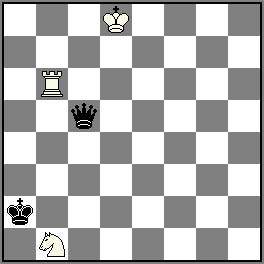
3K4/8/1R6/2q5/8/8/k7/1N6
W : Kd8 Rb6 Nb1
B : Ka2 Qç5
= (3+2)
And to conclude the study part, a fantastic composition
4 - White to play and win
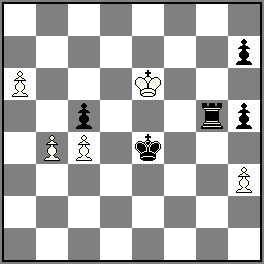
8/7p/P3K3/2p3rp/1PP1k3/7P/8/8
W : Ké6 Pa6b4ç4h3
B : Ké4 Rg5 Ph7ç5h5
on 1 a7, 1 ... Rg6+ and Ra6 immediately quiet
Investigate this problem, you won't waste your time
5 - game of the day Petrosian - Gligoric 1970
1 c4 g6 2 Nf3 Bg7 3 d4 Nf6 4 Nc3 0-0 5 e4 d6 6 Be2 e5 7 0-0 Nc6 8 d5 Ne7 9 b4 Nh5 10 Nd2 !?
One also plays g3 or Re1 to counteract Nf4
10 … Nf4 11 a4
With idea Ba3 followed by c5
11 … f5 12 Bf3 g5 !
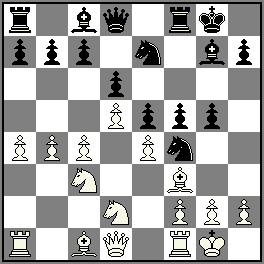
12 … Nd3 13 Ba3
13 ef Nxf5 14 g3
14 Nde4 Nh4
14 … Nd4 !
But 14 … Nh3+ 15 Kg2 Qd7 ! also works
15 gf
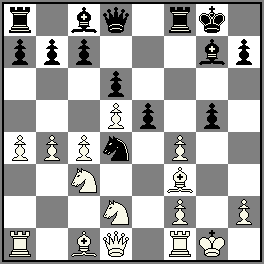
Petrosian accepts the gift 15 Bg4 Bxg4 16 Qxg4 h5 17 Qd1 Nh3+ 18 Kg2 g4 19 f3 Qd7
15 … Nxf3+ 16 Qxf3 g4 17 Qh1 ef 18 Bb2 Bf5 19 Rfe1 f3 20 Nde4 Qh4 21 h3 ? Be5 ! 22 Re3
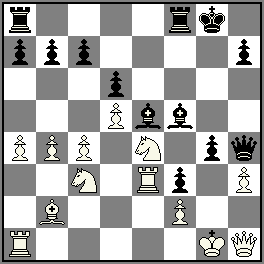
22 hg ? Qxg4+ 23 Kf1 Bxc3
22 … gh 23 Qxf3 Bg4 ! 24 Qh1
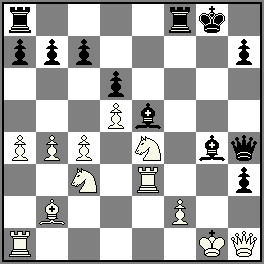
Switchback !!
24 … h2+ 25 Kg2
25 Kf1 Rf3
25 ... Qh5 ! 26 Nd2
switchback !! 26 Ng3 is not recommended
26 … Bd4 ! 27 Qe1
The threat was Rxf2
27 … Rae8 28 Nce4 Bxb2 29 Rg3 Be5 30 Raa3 Kh8 31 Kh1 Rg8 32 Qf1 Bxg3 33 Rxg3 ? Rxe4
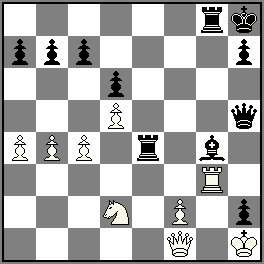
resigns
Of course, in the electronic version of the Master you will find many more variations, and correct ones at that!
The restoration started with Roses
6 - serial helpmate 3 moves with Roses
Gerard SMITS
The Problemist 2009
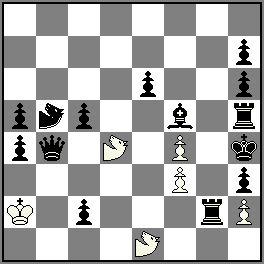
8/7p/4p2p/pop2f1r/pq1O1P1k/5P1p/K1p3rP/4O3
W : Ka2 Pf4f3h2 ROd4é1
B : Kh4 Qb4 Rh5g2 Bf5 Ph7é6h6a5ç5a4h3ç2 ROb5
sh‡3 (6+14) C+
2.1.1.1
RO=Rose : Extended but rounded knight
To help you a bit, Rg2 is pinned by ROe1 and the Bf5 by ROd4 and more complicated, if you remove pc2 and Qb4, Kh4 is in check by ROe1
All this will help in the resolution but there are more things to see, of course
And as it was late, the Nightrider arrived before the Master took the Noctambus
7 - hs#2,5 Take&Make - Anti-Andernach with Nightrider e3
Petko A. PETKOV
1st Prize
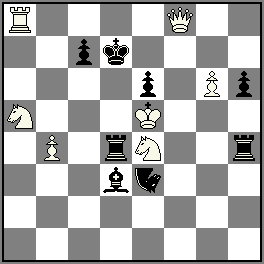
R4Q2/2pk4/4p1Pp/N3K3/1P1rN2r/3bn3/8/8
W : Ké5 Qf8 Ra8 Na5é4 Pg6b4
B : Kd7 Rd4h4 Bd3 Pç7é6h6 Noé3
hs‡2,5 (7+8)
b)Na5->g8
c)pb4->f6
Take & Make : a capture is followed by a movement of the capturing piece with the characteristics of the captured piece
Anti-Andernach : if a piece plays without capturing, it changes colour
N=Nightrider : Extended knight: Noe3 can go to c2, a1, f5 g7, c4, a5 and d5
It's Petkov, so it's top class.
For some time now, he has been moving towards enchantment, to our great pleasure.
A very beautiful problem
The next session, which I hope will be a little more crowded, will be held on 23 April.
Good reading to all
Sincerely yours
Le greffier
Add a comment